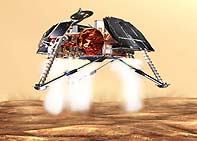Mars Polar Lander Descent Imaging: Two Minutes of Work

Mars Polar Lander during terminal descent.
Descent imaging systems have a tough job. They wait around for a long
time and are then asked to perform everything they will ever do in a very
short time. There are no second chances. They have to work the first time.
For the Mars Polar Lander MARDI, descent imaging activities begin about
2.5 hours before entry, when the entry, descent, and landing (EDL) sequence
powers-on the MARDI heater to bring the camera to its operating temperature.
The following steps outline what happens next, all the way down to the
surface of Mars:
- The heater is turned off 24 minutes before entry.
- At entry minus 15 minutes, the MARDI software within the spacecraft
computer begins running.
- Thirty seconds before parachute deployment, the camera itself is
powered-on and the software within the spacecraft computer transfers
additional, critical operating software into the camera's small but
very powerful internal processor.
- Imaging begins 0.3 seconds prior to the Polar Lander's heatshield
jettison (9.7 seconds after parachute deployment).
- Imaging continues every 0.5 seconds throughout the heatshield
jettison event. These subsected images (256 pixels square) show the
heatshield interior surface for calibration purposes.
- Surface observations begin with a full-field image approximately
2 seconds after heatshield jettison (altitude ~6-10 km).
- Images at 8 km (5 miles) altitude will cover just under
75 square kilometers (47 sq. mi) at a resolution of 8.5 m/pixel (28 ft/pixel).
- Pictures are taken every 5.3 seconds thereafter. Each full-frame (1000 X
1000 pixel) image is edited to approximate the circular field-of-view of
the camera (saving about 20% in data storage and transmission) and losslessly
compressed (saving another 40%).
- Immediately after parachute/aftshell jettison
and before the beginning of powered descent, an image is acquired; this
image constitutes the last full frame acquired during unpowered descent.
- A maximum of 16 parachute descent images can be stored. If parachute descent
takes longer than 85 seconds (more than 16 images), a sieving algorithm
will be employed to control overwriting image storage memory in such a way
as to preserve images that effectively sample the entire range of altitude.
- Five seconds after powered descent begins, imaging continues on a one per
4 second schedule that continues until touchdown. These
"powered descent"
images are 800 X 800 pixels, square, and again, losslessly compressed.
- A maximum of 10 powered descent images can be stored. If powered descent takes
longer than 45 seconds, the sieving algorithm is employed to control
overwriting the images stored in memory.

The figure above shows a representative Mars Polar Lander descent
profile, at two scales. The right graph shows the profile from heatshield
jettision to touchdown, marked in 10 second increments (+). The small dark
dots represent image acquisitions. The left graph is an enlargement
of the terminal descent. The total descent can take from as short as 70
seconds to as long as 180 seconds, depending on events that occur earlier
in the entry and descent. Powered descent, using the hydrazine engines,
can last up to 45 seconds, although virtually all simulation scenarios limit
powered descent to a window between 32 and 38 seconds in duration.
Artwork: NASA/JPL/Caltech; Chart: NASA/JPL/MSSS
©1999 Malin Space Science Systems, Inc.



![]()